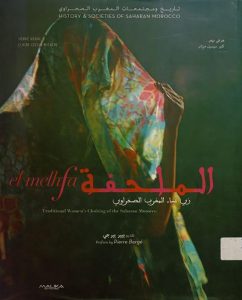![]() Hervé Nègre & Claire Cécile Mitatre
Hervé Nègre & Claire Cécile Mitatre
![]() Malika Éditions
Malika Éditions
![]() Morocco
Morocco
![]() Art Book
Art Book
![]() Arabic, English & French
Arabic, English & French

ISBN 978-9954-9470-1-2
Translated into French by Sandra Freland and into Arabic by Ahmed el Bachir Damani
All along the Atlantic coast of the Sahara, from the foothills of the Atlas Mountains to the banks of the Senegal River, the women of Saharan Morocco and Mauritania draped themselves in the same measure of fabric that they arrange in a similar movement. The melhfa, whose Arabic literally means “to cover”, “to wrap”, is wrapped around the body to be knotted at the shoulders before covering the hair, the end of the cloth being thrown back over the left shoulder. In this beautiful trilingual book, in French, English and Arabic, prefaced by Pierre Bergé and supported by the Agence du Sud, the photographer Hervé Nègre and the ethnologist Claire-Cécile Mitatre retrace the history of this garment which resembles the Indian sari and which competed with the djellaba when the haik was abandoned.
Hervé Nègre is a photographer, and has travelled the world, from Cameroon to Japan and from India to Central Europe. He has published his reports in prestigious magazines such as Géo, Marie and has worked for the CNRS and the Musée de l'Homme. He is the author of more than thirty books.
Claire Cécile Mitatre, doctor in ethnology, was a researcher at the Centre Jacques Berque in Rabat, she taught ethnology at the University Paris X Nanterre and carried out consultations on the intangible cultural heritage of southern Morocco. She works on rituals, kinship and local representations of nomadic culture and heritage.
ترجمه إلى الإنكليزية: ساندرا فريلاند، وإلى العربية: أحمد البشير دماني
على طول الساحل الأطلسي للصحراء الكبرى، ومن سفوح الأطلس إلى ضفاف نهر السنغال، ترتدي نساء المغرب الصحراوي وموريتانيا قطعةً من القماشٍ تحمل التصميم نفسه، يقمن بتكييفها بالأسلوب نفسه. تُلَفّ الملحفة حول الجسد ليجري عقْدُها على الكتفين قبل تغطية الشعر بها، بعد أن يُسدَل طرفها للخلف من فوق الكتف الأيسر. في هذا الكتاب المصوّر ثلاثيّ اللغة (بالعربية والفرنسية والإنكليزية)، الذي كتب مقدّمته بيير بيرجيه وتلقّى الدعم من "وكالة الجنوب"، يتتبّع المصوّر هيرفيه نيغر والباحثة في الإثنولوجية، كلير سيسيل ميتاتر، تاريخَ هذا الثوب الذي يشبه زيّ الساري الهندي والذي شكّل منافساً للجلّابة بُعيد التخلّي عن زيّ الحايك.
هيرفيه نيغر مصوّرٌ طاف العالم، من الكاميرون إلى اليابان ومن الهند إلى أوروبا الوسطى. نشر تقاريره في مجلّات مرموقة مثل "جيو" و"ماري"، وعمل لصالح المركز الوطني الفرنسي للأبحاث العلمية، وكذلك لصالح "متحف الإنسان" في باريس. له ما يقارب ثلاثين كتاباً.
كلير سيسيل ميتاتر حاصلة على دكتوراه في الإثنولوجيا. عملت ككباحثة في "مركز جاك بيرك" في الرباط، وقامت بتدريس الإثنولوجيا في جامعة باريس العاشرة (نانتير) وقدّمت استشارات حول التراث الثقافي غير المادي لجنوب المغرب. تعمل على مسائل الطقوس والقرابة والتمثيلات المحلّية للثقافة وعلى التراث البدوي.



